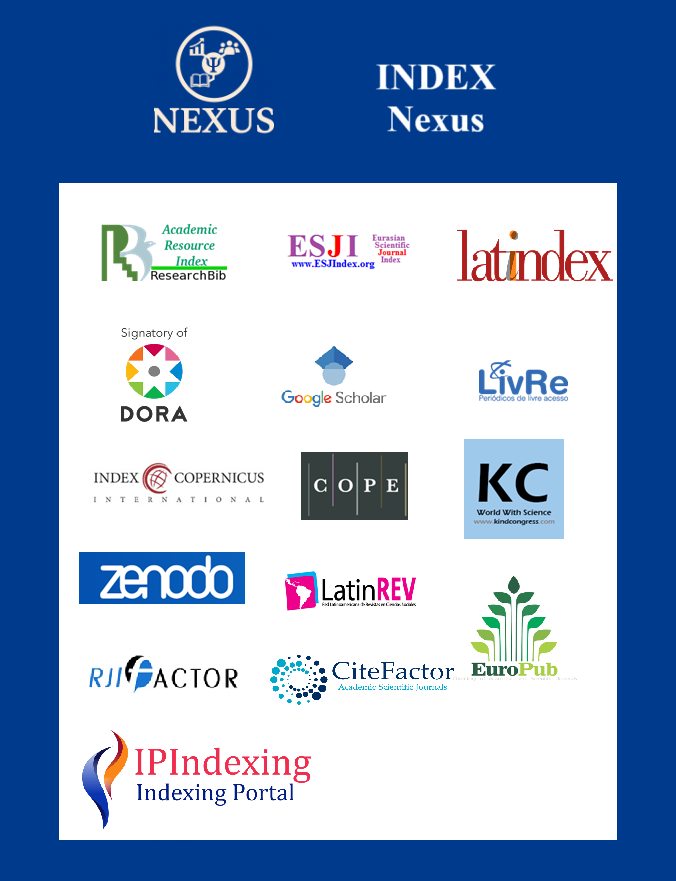Code of Ethics
Code of Ethics and Good Editorial Practices Nexus Journal: Multidisciplinary Research Journal (MIR)
This code is based on the Principles of Transparency and Good Practice in Academic Publishing established by the COPE Committee on Publication Ethics: http://publicationethics.org/. It is intended for editors, reviewers, and authors in general.
Nexus: Multidisciplinary Research Journal (MIR) disclaims any liability for any potential disputes arising from the authorship of the works it publishes.
The submitted work must be unique and not under review by any other publication. As part of its editorial policy, Fuentes Journal employs anti-plagiarism tools to prevent the fraudulent use of protected content. All information contained in manuscripts must have the required permissions for its dissemination, particularly with regard to materials extracted from other publications and information related to individuals, for which informed consent is required.
If the manuscript is accepted, each individual responsible for the authorship grants Fuentes Journal the rights to the work for publication under the international license Creative Commons Attribution-NonCommercial-ShareAlike 4.0 International (CC BY-NC-SA 4.0).
In the context of scientific journals, the code of ethics consists of a set of rules and principles that guide the actions of those involved in the generation and dissemination of knowledge: researchers, authors, reviewers, journal editors, editorial board members, among others. Regarding best practices, these act as guidelines for the actions carried out by these actors through the detailed definition of concepts, goals to be achieved, and criteria to be considered in decision-making. These two elements, along with the guidelines established in each journal's regulations, its internal regulations, and evaluation processes, constitute a framework for strengthening editorial management.
- Commitments of the authors
Initial needs: Before submitting articles to Íconos, authors must confirm that they have read and understood the submission requirements detailed in this section, that they agree with the journal's article selection procedures, and that the submitted texts comply with Íconos' publication regulations.
Various and/or recurring publications: Writers should avoid submitting their work simultaneously or multiple times to different publications or publishers, as the same work may be published more than once. This does not represent moral or accepted professional conduct.
References: It is essential that authors identify the original sources of the materials used in the creation of their works to prevent plagiarism. This deliberate act of omitting authorship of fragments or the entire work can manifest itself in various ways: a) verbatim copying, when a work is reproduced word for word, in whole or in part, without authorization and acknowledgement of the original source; b) substantial copying, linked to research materials, procedures, tables, or equipment; c) paraphrasing,
Intellectual eigentum: If the materials used in the preparation of the article are not their own, the authors must respect the intellectual property rights of third parties. Therefore, they must have the required authorizations for the reproduction of photographs, illustrations, graphs, charts, maps, diagrams, among others. In the research and publication process, authors must prevent fraudulent behavior, which occurs when data or conclusions are disseminated that did not originate from experiments or observations, but rather through invention/fabrication or falsification/manipulation, which includes the alteration or suppression of essential data or results.
Authorship: There are two key criteria for authorship: a) having significantly contributed to the conception and design of the research, data collection, or analysis and interpretation of the study; b) having written the first draft or revised the intellectual content of the article. Authors are classified according to their level of responsibility and involvement in the submitted work.
Difficulties in the published articles: When a writer detects a serious error or inaccuracy in their work, they must immediately notify the journal's editorial team and provide all the information required to make the corresponding corrections. These corrections will be made as quickly as possible in the digital version of the journal and through an errata in the printed version.
Responsibility: All authors assume responsibility for what has been written. Authors also acknowledge that a review of the most recent and relevant scientific literature on the subject studied has been conducted, taking into account the various trends in knowledge in a diverse manner.
- Editors' Commitments
Publication decision: The editors will ensure the selection of the most qualified reviewers and scientific experts to offer a critical and specialized assessment of the work, thus avoiding any possible bias. Honesty: The editors evaluate articles submitted for publication solely based on the scientific merit of the content, in accordance with the publication's editorial policy.
Confidentiality: The authors, as well as the members of various boards and staff, agree not to disclose information related to articles submitted for publication to individuals other than the authors, reviewers, and editors. Anonymity is used to maintain intellectual integrity throughout the process.
Confidentiality: The authors, as well as the members of various boards and staff, agree not to disclose information related to articles submitted for publication to individuals other than the authors, reviewers, and editors. Anonymity is used to maintain intellectual integrity throughout the process.
Conflict of interest and disclosure: The editors undertake not to use in their studies the contents of the articles submitted for publication without the written authorization of the author.
Periods of the editing processThe editorial team is obligated to promptly notify the recipient of the receipt, evaluation, decision, and assessment, correction, or rejection of the submitted works within a period that generally does not exceed 90 days.
- Evaluators' Commitments
Contribution to the editorial resolution:Individuals who undertake to review the submitted works must conduct a critical, constructive, and unbiased review, with the goal of ensuring scientific and literary excellence in their field of study.
Time management: Reviewers are responsible for evaluating submissions as quickly as possible to meet deadlines, thereby improving editorial administration. Reviewers who are not qualified in the subject matter under review or who fail to complete the evaluation within the established timeframe will immediately inform the editors.
Objectivity:The review will be as impartial as possible, avoiding individual judgments about the authors. All assessments should be supported in a report. This report should be as complete as possible so that the authors can clearly understand the proposed modifications or corrections, or, if the work is rejected, understand the reasons for such a decision. Similarly, if any conflict of interest arises, the work should be declined for review.
Privacy: Manuscripts are distributed altruistically. However, each assigned text must be treated as confidential. Therefore, these texts should not be discussed with third parties without the explicit permission of the authors or editors.
Text Display or Literature Source References: Reviewers undertake to accurately identify bibliographic references for essential works that may have been overlooked by the author. The reviewer is also obligated to notify the editors of any similarities or overlaps between the manuscript and other published works.
Conflict of interest and publication:Private information or data acquired during the peer review process must be protected and may not be used for personal purposes. Reviewers only review a manuscript if there are no conflicts of interest.









